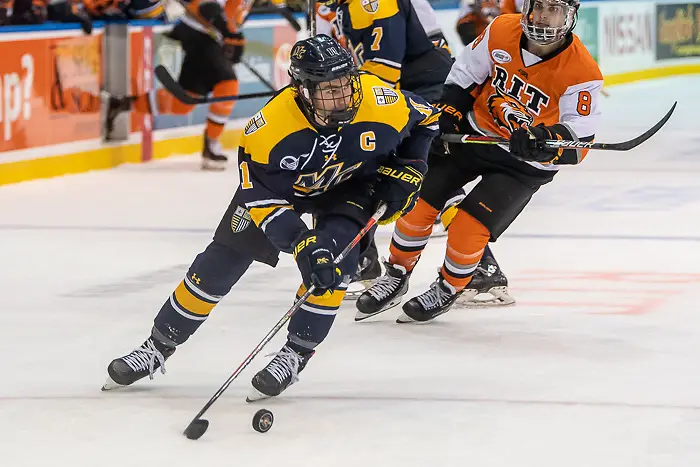
Each week during the season, we look at the big events and big games around Division I men’s college hockey in Tuesday Morning Quarterback.
Jim: This weekend’s results, Paula, have seemingly cemented one thing in the minds of USCHO poll voters – Denver and Minnesota State are clearly the top two teams right now.
They were the only two teams to receive first place votes and, not surprisingly, perfect 6-0-0 Denver led the way with 47 of those 50 votes. Both certainly deserve their status.
But the one team that might be wanting to sound an early alarm is two-time defending national champion Minnesota Duluth. The Bulldogs were swept on the road this weekend at Wisconsin, hardly a slouch team. But that drops the Bulldogs record to 1-3-0. Should that be a cause for concern?
Personally, I say no. Scott Sandelin has always had a good feel for his team and early losses haven’t exactly sacked this team in recent years. Last season after going winless in the opening weekend, the Bulldogs snapped off eight straight wins and 10 off 11. Two seasons ago was even more grim as the Bulldogs started out 0-2-3 and 3-5-3. Of course, we know what the end results of the last two seasons were.
But I’ll pose the question to you: Any reason for extreme concern for the Bulldogs?
Paula: I could almost feel the alarm from Duluth fans coursing through the Internet after the decisive loss to Wisconsin Friday and by the end of Saturday’s loss, the onset of panic was palpable – but I’m with you.
Bulldogs fans should have a little faith that Sandelin knows what he’s doing after back-to-back national championships.
As you point out, Minnesota Duluth had a very slow start to the 2017-18 season and the Bulldogs were 2-1-1 at this point last year. All but four skaters who have seen time this season for Duluth have experienced a national championship, and we both know what that does for a team.
One reason for concern that I’ve heard is the relative strength of schedule the Bulldogs have faced in these first two weeks of the season, but I don’t see UMass Lowell as a slouch and I suspect that many teams will be exploited by Wisconsin’s offense before this season ends. Wisconsin, especially, has been rebuilding for a few seasons, and it may be difficult for some fans to accept that the Badgers may have arrived.
I don’t think there’s any reason for any team to have extreme concern yet this season, with the exception – perhaps – of Arizona State. As the only independent team, the Sun Devils need to play their way into the NCAA tournament on the strength of PairWise alone, and a 3-3 start is not what they desired. Granted, they split with an improved Mercyhurst team and dropped two games to a Minnesota State team that will undoubtedly be in the mix at the end of the season and they swept Air Force with an impressive goal differential, but the Sun Devils will have to dispatch of many opponents they should beat and defeat a few they’re not expected to in order to earn a repeat invitation to the tournament.
But – again – it’s awfully early.
Jim: I do have concerns about Arizona State.
Last year, an incredible year for the Sun Devils, I feel like Arizona State snuck up on a lot of opponents.
That is one of the most difficult things to understand for up-and-coming teams. There is something exciting and enjoyable about being an underdog. Reverse that role and things become much more difficult.
Look at Atlantic Hockey as a conference. That was a pushover league for many years. But the last few seasons that team has also won its opening game of the NCAA tournament. Atlantic Hockey always feels like an underdog, but over the first 15 nonconference games was 7-7-1.
Since that time, AHA opponents seem to have awoken and a .500 record turned into a .333 mark, back in line with past seasons.
It is difficult to reach college players, but the best teams need to play hard to rise to the top.
Paula: And building a consistent level of excellence – staying at the top – is something that is so very hard to do. Look at Michigan and Boston College, for example, to programs that a couple of decades ago were always big on the national scene. Each has been coached exceptionally well. Each has benefited from that sustained excellence with enviable recruits. Each, now, is looking to return to a level of play and success that was almost a given, year in and year out.
All of this brings to mind the series between Alaska and Penn State this past weekend. The first night, the Nittany Lions trounced the Nanooks 7-0. The following night, Alaska returned that favor by delivering a stunning 4-0 upset. After Saturday’s game, coach Guy Gadowsky talked about how that single loss should prompt a lot of self-examination in Pegula Arena.
And all of this brings to mind the outlier status of some schools like Arizona – an independent – and Alaska, geographically isolated. Then there’s the WCHA, which wants to jettison Alaska, Alaska Anchorage, and Alabama Huntsville from the conference because the travel issues are so great.
Two weeks ago when Clarkson played Michigan in Ann Arbor, people in the Michigan press box were surprised to learn that the Golden Knights made the 500-mile trip by bus rather than plane. Some schools don’t have the means to travel by air, even when the distance is great. For some schools with more generous travel budgets, a bus trip can be an event that helps build team chemistry.
There is so much that goes into the logistics of travel for college hockey that I wonder if some programs – and not just the ones I’ve mentioned – are destined to be perennial outliers.
Jim: Ah, college hockey travel.
That’s such an interesting subject based on many aspects of funding of your athletic program.
Certainly there are teams that have plenty of money and their hockey teams can take charter flights anywhere they want. Notre Dame and Michigan both come to mind, but there are many others.
Then there is the actual geographic makeup of your league. If you’re in the ECAC and Hockey East, your team might hop on a flight once a year, if even that. Some schools might have ability to charter but most fly commercial airlines. Not the most convenient, but still easier than taking a bus. In the WCHA, for example, how many long bus trips might teams take? I know Alabama Huntsville often buses to league games on a sleeper bus. Sometimes, that’s actually not the worst accommodation compared to the potential for delays and problems associated with air travel.
But let’s look at recent national champions. Most of those programs don’t seem like teams jumping on a charter flight every weekend. Maybe some have elevated. Providence, for example, got a massive donation from a booster after their 2015 championship that allows the team to charter once per year, I believe on the interest alone. But for the most part, the average team go through travel struggles whether it be lost luggage or spending 14 hours on a bus. None of it is luxurious, despite what fans might think.
Paula: I am always a little perplexed when fans assume a level of luxury throughout college hockey that does not exist – in spite of the comfort with which most teams actually do travel. I think it speaks to our overall sports culture in general, that tendency to see athletics as an elite group because it is for many reasons, but not necessarily in the ways that we think.
Also, that assumption of luxury when it comes to college hockey speaks volumes about the heightened profile of the sport itself. You and I and all fans of the sport lament that college hockey doesn’t get the exposure we think it deserves relative to the product itself, and we all want to see the sport grow even though we know how expensive an undertaking that is. In spite of all of that, we all perceive that D-I men’s hockey in particular has grown in both stature and popularity.
Maybe there’s something to that. Social media makes nearly everything immediate and sometimes amplifies things we wish that it wouldn’t, but there’s no question that it contributes to every aspect of the game – from which programs young, talented players dream of joining to the ways in which programs market themselves to an overall awareness of the game.
College hockey will always face an imbalance in funding because of the makeup of membership in a small pool of D-I teams, but as you pointed out with your example of Atlantic Hockey, that no longer automatically means a discrepancy of quality.


